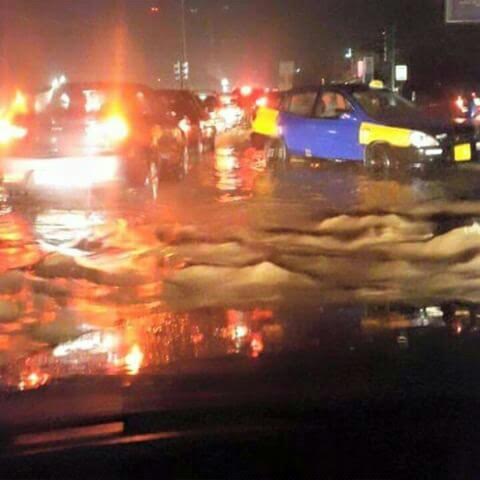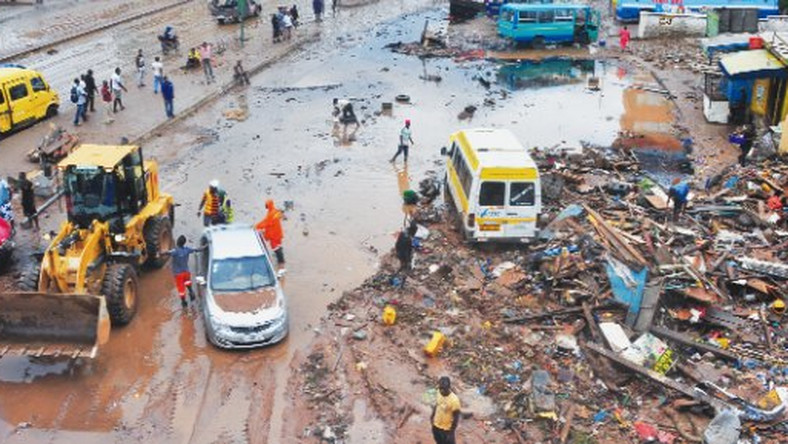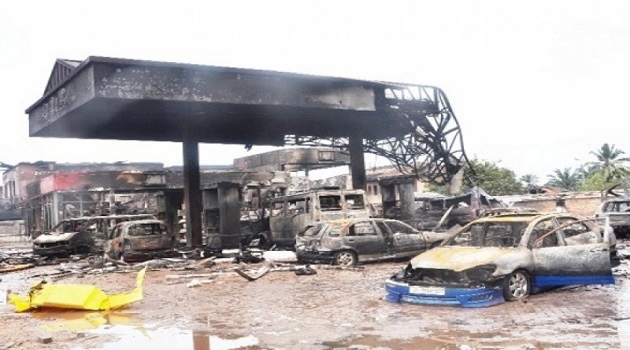ACCRA, Ghana – Wednesday, June 3, 2020/ https://africanpostonline.com/–Wednesday, June 3, 2015, would be remembered as the day Accra drowned and exploded by combined effects of flood and inferno from incessant rains, rising water levels and the heart-breaking deaths of many. We have felt, seen in pictures and video of the untimely deaths of people in arguable Ghana’s worst disaster. They were caught unawares and could have happened to anyone. The disaster is dubbed the “Black Wednesday”

One lucky survivor described what happened at the exact moment: “So June 3, 2015, will be a day I will forever remember. I was going home en route circle when the rains started. I decided to take solace at Honest Chef Restaurant as the streets began flooding up and there was no car. After some hours, the restaurant began flooding up as well so all of us stood in the flood on a higher ground to keep from drowning; there were more than 25 people there. WE COULD SMELL FUEL in the water coming from the GOIL FILLING STATION which was about three blocks away. Just when we decided to move by hook or crook, there was an explosion possibly caused by the gas from the kitchen and the fuel in the water. I SAW THE MAN HOLDING MY HAND CAUGHT FIRE RIGHT BEFORE MY VERY EYES. He pushed me under the water together with a woman and her baby, (she had drowned). I thought I was dead because I was so sure I had caught on the fire (which had engulfed almost everyone around me) UNTIL A MAN FROM NOWHERE PULLED ME OUT AND ASKED ME TO SWIM OR RUN THROUGH THE WATER. NOW THIS MAN WAS NOT ON FIRE NEITHER WAS HE RUNNING FOR HIS LIFE; HE JUST PULLED ME OUT AND ASKED ME TO RUN; I NEVER SAW HIM AGAIN! I HAD NO BURNS TO THE GLORY OF GOD! I STILL CANT BELIEVE I’M ALIVE. GOD IS GREAT AND I AM ETERNALLY GRATEFUL FOR THIS MIRACLE” (Agnes Matilda Mends-Armstrong).
Many others were not so lucky to receive divine intervention for a second chance in life like Agnes. Official figures for the death toll from the flood and explosion is put at 150 people but other sources quoting rescue workers list 256 and say they expect the numbers will keep climbing as they continue to dig debris. The magnitude of the disaster has overwhelmed the emergency services who are struggling to cope. It was a disaster waiting to happen because Accra was not designed for and has not adapted to its current function. Accra still has old waterways that presuppose a certain amount of natural vegetation, overflow rates, paths to the sea, seepage, rainfall patterns, etc. all of which drastically change over time. The city has not seen any continuous mapping that necessarily shows evolution.

Geographically, Accra lies on latitude 5.56⁰ N and longitude -0.2⁰W with an elevation of 91metres above sea level implying it is largely composed of lowlands. The elevation is an important element in the concept of human settlement especially in relation to drainage and water flow. Though Accra is coastal lowland, yet densely settled and growing rapidly making it vulnerable to the risk of disasters resulting from a combination of forces of nature and man. Historically, Accra, the most populated city in Ghana, was founded circa 1400 originally as a collection of Ga villages but coalesced to form a city when it was made the capital in 1876. It is sprawling with a mixture of modern buildings, shanty towns and bustling with an array of activities.

Government has declared 3 Days of National Mourning and pledged to implement pragmatic measures to end disasters including perennial flooding. It claims it has done everything possible having visited, spoken, sympathised, commiserated, philosophised, ordered, directed, and even cut a sod to dredge and build the drains. Evidence to the contrary points to leadership let-down, gargantuan corruption, and chain of systemic institutional failures.
Samia Nkrumah, daughter of independent president, Kwame Nkrumah and chairperson of the Convention People’s Party (CPP) says the disaster could have been avoided with proper planning that takes into account the growing urban population. This is a man-made disaster due to a failure of leadership over decades. Of the 22 flood disasters recorded in Ghana between 1968 and 2015, 68.18% (15) occurred between 2010 and 2015 implying the frequency and pattern is deteriorating. Coincidentally, 68.18% involved the city of Accra confirming that Accra is lowland and vulnerable to the risk of flood disasters. The big question is why is flooding on the ascendency in Accra?
Though the president concedes “that only a scientific and strategic approach to solving the infrastructural design of Accra would see an end to the seasonal catastrophes”, yet there is a subtle official attempt to shift the blame away from government to the citizens arguing that negative attitudes like indiscriminate dumping of wastes and erection of buildings are responsible for clogging drains. Consequently, they have opted to demolish buildings assumed to be impeding waterflow. This approach has been applied over the years but there is no evidence that it works. A number of civil society groups, religious organisation and rights groups have, however, rejected this stance. They say the failure of the city authorities to tackle the defects in the engineering of drainage system, de-silt drains, clear refuse, and enforce building and Fuel Stations Operations regulations, ended up exposing citizens to their untimely demise. They cite the construction of open gutter systems back this claim. Just to think of it, thousands of trees have been cut down to build houses for 3 million people, tar the paths to create highways for 200,000 cars, concrete over half the topsoil, fill in undulations to build malls, and still relying on ‘natural waterways’ to drain rainwater to the sea. Can citizens be expected to solve this drainage problem in the middle of human-built environments?
There is lax and slack in enforcement of regulations on siting of building including fuel stations in the middle of residential and business areas. The purpose of town planning is to ensure sound living standards despite the limitations of nature. A proper city is one that continually updates its urban mapping taking into account all the current economic realities aspirations of its inhabitants and makes planning decisions on flood management systems. The over a century old Towns Act of 1892 and Local Government Act, 1993 (Act 462) 64 on regulating building permits have not only overstayed their relevance but, most significantly, they mean nothing as laws because they simply remain in statute books and are never enforced. Take for instance the issue of securing building permit. The phenomenon of “unauthorised buildings” is a part of a system that is set up to fail. It is set up to make sure that building inspectors earn some money on the side, and to ensure that there is no honest person in the system. This is why the situation about removing buildings and settlements that impede the flow of water, is complicated and needs a lot of sober, critical and deep thinking.
Frequent and unresolved fire cases especially “market fires” have lately plagued the country. No one has ever been prosecuted. Many Fuel Stations are located in the midst of residential and commercial buildings but the monitoring and evaluation of their safety by the regulatory bodies (by Environmental Protection Agency and National Petroleum Authority) is a source of concern to many. In 2014, properties lost in fire outbreaks nationwide were estimated at a total of Ghc13, 846,786 in 3,870 fire incidents, with 32 people losing their lives. The records for 2013 indicate that Ghc25, 094,369 was the cost of loss of properties in 5,496 fire cases. Domestic fires topped with 1,665 cases, vehicular fires 522; electrical fires 499; commercial fires, 461; bush fires, 207; industrial fires, 92; institutional fires, 89; and others, 335. The identified causes points to systemic institutional failure to enforce safety regulations. According to the Ghana National Fire Service, their investigations into various fire cases have identified the causes of fires as faulty electrical parts, power fluctuations, socket overload, and use of substandard electrical parts. Human factor identified includes negligence, carelessness and ignorance. Inappropriate installation and use of liquefied petroleum Gas (LPG), dumping of hot ashes in refuse containers and dry grasses, smokers, herdsmen on farm cooking, and hunters, causes bush fires, the refusal to create fire belt around buildings and children having access to matches in the homes complete the list.
Further, official corruption is also a major contributory factor to the poor sanitation conditions.
The Communications Service Tax (Talk Tax Act, 2008 (Act 754) was put on the value of services accessed by subscribers of mobile telephone networks to generate revenue to fund the activities of the then National Youth Employment Programme (NYEP – rechristened Ghana Youth Employment & Entrepreneurial Development Agency [GYEEDA]) which was mainly dealing with sanitation. The Report of the Auditor-General on the Public Accounts of Ministry of Youth and Sports for the year ended 31 December 2013 (Part III, paragraphs 1629-1716, at pages 426-446) revealed total GH¢107,312,363.35 (US$26,828,090.84 of public funds (specifically from the Communication Services Tax) was improperly and illegally spent by GYEEDA in suspicious and Ponzi-like transactions with 11 companies. This corrupt act alone impacted the ability to pay for the services of refuse collection companies. As a direct result, in 2014 Ghana recorded its worst cholera cases in 32 years (since 1982). To make up for its failure to the people, government introduced what it called National Sanitation Day for every first Saturday of every month. After 8 months, the country recorded the worst disaster related to poor sanitation. This is the price we pay for corruption.
Popular playwright and motivational speaker, Uncle Ebo Whyte offers these LESSONS. Always be prepared for the inevitable and never take life for granted. Second chance only exists in Hollywood.
A stitch in time saves nine; it pays to take remedial actions at the right time. Do what has to be done because negligence can cost lives. People need to be saved from themselves by the state by enacting and enforcing laws. People must respect rules and regulations. Bright Simons of think tank IMANI Ghana and M-pedigree suggests a crude roadmap for the way forward. Avoid hasty, knee-jerk, actions. Update Accra’s hydrological and urban geography maps. Identify all the major incident sites of the last 10 seasonal floods and plot a detailed scatter diagram as a starting point for developing a flood model. Ground the flood model by benchmarking the hydrological studies with the observed actual patterns of flooding hotspots. Confirm if the bottlenecks preventing existing drains from working optimally are indeed due to obstruction of waterways, either natural or artificial. Compare the costs of removing obstructions and creation of diversions for rainwater movements. Based on outcome of comparison, embark on a public enlightenment campaign. Offer owners of economically viable obstructions the option of paying for diversions or to face removal. Implement targeted flood control interventions based on sewer systems in hotspots. Periodically Review performance of action plan.
The Black Wednesday is another wake up call to address the long-standing infrastructural problems that lead to what is becoming a seasonal occurrence. Government and its agencies must accurately prioritise projects based on their importance, visibility and other attributes. Reducing the risk of disasters in Accra to achieve sustainable development will require a combination of mitigation, settlement modification enhancing adaptive capacity, attitudinal change, and in the long term migration or relocation of the national capital.
By Kojo Gyabaah – African Post Online
Read Also
- Senegalese President declares today a public holiday to celebrate AFCON win
- Fall in Love with Love at Banyan Tree Ilha Caldeira, Mozambique
- Ghana: The story of a coconut company that exports throughout the world
- Axim Government Hospital shuts two facilities to shoot Hollywood movie; residents cry foul
- Honoring Archbishop Desmond Tutu, An Advocate and Believer in Humanity

Putting a spotlight on business, inventions, leadership, influencers, women, technology, and lifestyle. We inspire, educate, celebrate success and reward resilience.















